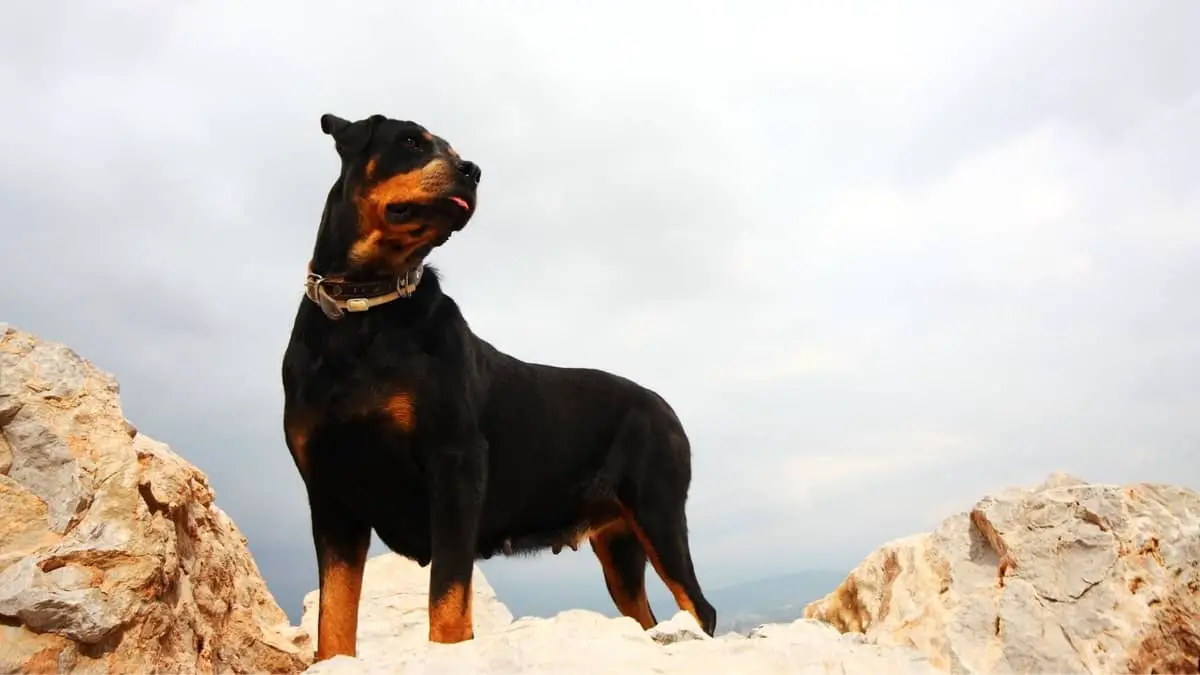Last Updated on May 26, 2022 by
It’s natural to wonder about Rottweilers 100 years ago – they’re one of the oldest dog breeds known to man, not to mention that they looked like a completely different dog breed back in the day. Rottweilers weren’t always the beautiful beasts we know and love today. In today’s article, we’ll be taking a historical overview of this beautiful breed!
Table of Contents
War Dogs
Rottweilers draw the earliest notes of their history in Roman times. These dogs distinguished themselves as a single breed during the Roman era, where they worked as herd dogs and driving dogs, but they were quickly recruited for the military. Romans brought them over the Alps, where they primarily drove and guarded cattle herds.
They quickly proved to be very valuable companions, as they were also very protective over their territory and their Roman masters – not just over cattle. This made them great guard dogs, and the Roman military quickly saw their usefulness. Rottweilers most likely descend from some sort of Mastiff dog, an ancient breed, which makes them great for guarding cattle and military camps.
It is understood by experts today that some of these breeds, including the Rottweiler, actually descend from Molossus – an extinct breed of a large Mastiff-like dog that’s strong, protective, and intelligent.
As Romans took them to modern-day Germany, German tribes repelled Romans. As they turned back, they left their dogs behind, but the Germans gladly adopted them and bred them with local dogs. They primarily settled in Rottweil, a town in Germany after which they were appropriately named.
Guard Dogs
After their brief stint in the Roman military, Rottweilers settled in modern-day Germany, where they primarily worked as butcher dogs. They weren’t actual butchers, but they protected butchers. Back then, meat was difficult and expensive to get, so butchers were often attacked and even robbed by people who couldn’t afford meat.
However, when Rottweilers came into play, everything changed. These dogs were vicious when it came to protecting their owner, and they didn’t let anyone touch the meat or the butcher. Since they were so strong, they had another job – they would pull carts with meat. Even though it might seem like an odd practice today, back in the Middle Ages – butchers would sell meat door to door.
These meat carts could weigh over 200 pounds, but Rottweilers are more than strong enough to pull that sort of cargo. During this era, they became very well known for three things.
Firstly, their protective instincts. Rottweilers wouldn’t let anyone get close to their owner, nor would they allow anyone to steal from their meat cart. Secondly, their tremendous strength was intimidating. Rottweilers have one of the most powerful bites out of all dogs, and a few would-be meat thieves learned that the hard way.
Lastly, they became very well known for their intelligence. They could easily be trained and butchers could teach them not to eat the meat out of the cart.
Learn more about: Where Did Rottweilers Originate From?
Rottweilers 100 Years Ago
Rottweilers reached the peak of their working life in the 1900s – as, during that time, Rottweil was the heart of cattle herding (at least for that region). That, naturally, drew a large number of would-be thieves and robbers to that area in an attempt to steal both live cattle and meat. Rottweilers were now proving their worth on basically a daily basis, as they were busy protecting their herd every single day.
After realizing the importance and the usefulness of these dogs, Germans started their German Rottweiler Club (DRK) in 1907, with the purpose of maintaining Rottweiler standards, as well as improving them.
During the 20th century, it became very obvious that Rottweilers are one of the most useful breeds of dogs on the planet. Just like Dobermans and German Shepherds, Rottweilers were very important as police and military dogs during the First and the Second World War. They were guards, messengers, draught, and ambulance dogs.
Because they’re so intelligent, they could be easily trained to investigate trenches and bark if they found enemy forces. When working as messengers, they were often delivering messages under heavy arms fire, something that people were unable to do.
The importance of these roles isn’t underestimated today, as Rottweilers are still widely used as service dogs for both the police and the military.
Dog breeds 100 years ago started moving across the Atlantic, and that includes the Rottweiler. This mostly happened during the 1930s. Ever since that period, there’s a distinct difference between German Rottweilers from Germany and German Rottweilers that were bred in the USA – as the USA family is usually a bit shorter and lighter.
That leads us to today’s ever-growing popularity of the Rottweiler. They’re still popular as service dogs for the police and the military, but they’re a popular family pet too, because of their protective instincts, but also because of their aloof and lovable nature – making them a great partner!
Read more about: What Were Rottweilers Bred For?
FAQ
How old was the oldest Rottweiler?
The oldest of Rottweiler probably descended from a Mastiff-like dog during the Roman era. They were used as cattle herders and guards, but also as camp guards for the military. With time, Romans took them to Germany, where they stayed and turned into the modern Rottie.
What is the history of the Rottweiler?
Briefly, Rottweilers are first seen with the Romans, working as war dogs and cattle herders. They're then taken to Germany, where they become very popular as guard dogs and later on as cattle herders. In the 20th century they fight in wars and move to the USA, after which they become the dog we know today.
To Sum Up
There are vast differences between dogs then and now, and Rottweilers have definitely changed. The only consistent thing about these dogs is that they were, and still remain, guard dogs and herding dogs – something that they were utilized for during their entire history. Rottweilers have historically been used by militaries and police forces, as well as butchers to protect cattle and meat from thieves.




